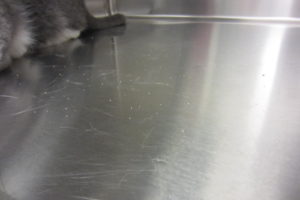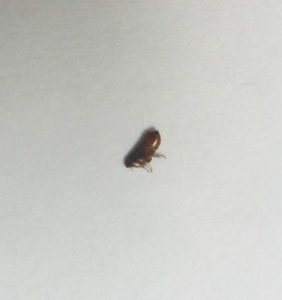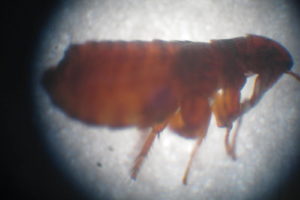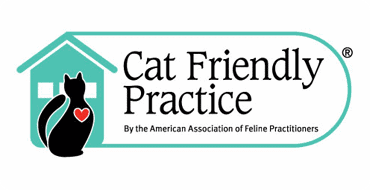We are in the height of flea season, so I thought it would be a good time for some flea pictures! If your pet has fleas there are a few things you should know. The most important is that the fleas you are seeing on your pet are just 5% of the population of fleas in your home. The other 95% is comprised of flea eggs, larvae (tiny maggot-like creatures), and pupae (similar to a cocoon). They are all in your carpet, floor boards, bedding, and couches. This picture shows in gory detail the reproductive capability of fleas. This cat had been in the kennel for just a few hours, and all those little white specks on the kennel floor are flea eggs that fell off of him in just that amount of time. The black specks are flea “dander”, essentially flea poop made up of digested blood. The larvae that hatch out of those eggs feed on flea dander until they reach the pupae stage.
This cat received a Capstar, a pill that will start killing fleas that are on the pet within 30 minutes. It only lasts for 24 hours, so he was also sent home with a topical flea preventative for continued flea control. Once he went home the kennel and the rest of the room he was in was sprayed with Knockout Area Treatment to kill any eggs that may have been left behind after cleaning.
If your pet has fleas, how can you treat for the other life stages hanging around in your house?
1. Vacuum, vacuum, vacuum!!! This will mechanically pick up eggs, larvae, and pupae. Also, the heat, movement, and vibrations will stimulate fleas to come out of their pupae, at which point they will either jump on your pet and be killed by the flea prevention that you are now applying religiously every 30 days, OR you will kill them with…
2. A household treatment. We like Knockout Area Treatment, but there are many available. Flea bombs can help, but they won’t get under furniture where fleas like to hide. Be sure to spray in those shadowy corners, and focus on areas that your pet spends a lot of time.
3. Make sure ALL your pets are on a flea preventative. This includes dogs, cats, even rabbits or other small mammals you keep in the house (call your vet for recommended products and doses). It does not matter if they aren’t itchy or you haven’t seen fleas on them. Be sure to get a good quality flea preventative. Cheaper options available through retail stores tend to be less effective.
4. If your pet spends a lot of time outside, you can treat places he sleeps in a lot with an outdoor flea treatment. Focus on shaded areas, under trees or on or under a deck.
If you are using a topical flea prevention applied to the skin, do NOT use flea baths after you have applied it (even if it is a week or 2 later). You will strip the oils off of the pet’s skin, and the flea product along with it. Flea baths will only kill the fleas that are on the pet at that particular moment, so they do nothing to address fleas that jump on them later. Find a soap-free shampoo to use with your topical product instead.
If you’re having trouble with fleas contact your vet to discuss a flea treatment plan specific to your situation.





